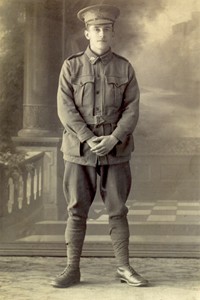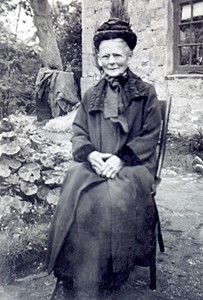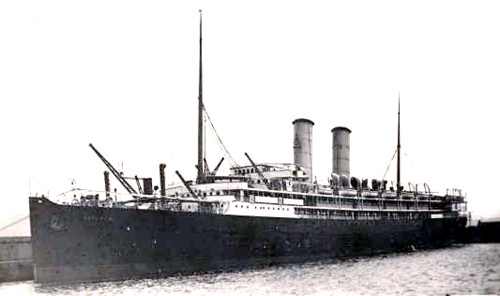|
The forgotten hero
WILLIAM WHILES MM
1888-1939
|
 |
William Whiles pictured soon after
enlistment and his mother, Jane Whiles, pictured outside her cottage
at Scottlethorpe. She survived him and died in 1952, aged 94. |
 |
The horrors of the Great War of
1914-18 in
which an estimated 10 million lives were lost and twice that number
wounded continue to fascinate, mainly because few families in Britain
were not affected by the conflict. New developments in genealogy have now
enabled us to research the lives of those ancestors who took part and this
voyage of discovery often reveals surprising information.
William Whiles was one such man whose heroism in the trenches is unknown
here in Bourne except to members of his family, particularly his nephew
John Thomas Whyles, aged 82, boot and shoe repairer, of Abbey Road,
Bourne, who now lives in retirement at Northorpe, near Thurlby.
The family name was originally Whyles, one of the oldest known names at
Scottlethorpe, first mentioned in the parish registers in 1773, but the discrepancy in the spelling
that resulted in Whiles
is believed to have been a mistake in 18th century documentation and was
put right by later generations.
Mr Whyles was so fascinated by tales of his uncle’s deeds that he
spent many months researching his life and the information he has obtained
has provided the basis for a profile of the man who left home to seek his
fortune in Australia, fought in the war in which he was decorated for
heroism and lived to tell the tale but died in the back of an ambulance on
the way to hospital twenty years later.
William Whiles was born at Scottlethorpe,
near Bourne, on 2nd February 1888, one of ten children, two girls and
eight boys, of George Whiles (1852-1914), who was employed as a carpenter
on the Grimsthorpe estate, and his wife Jane (née
Smith 1857-1952). After leaving school, he learned his trade as a
painter and decorator but found little appeal in village life so he
decided to emigrate, sailing for New South Wales early in 1910 aboard the
Orient Line’s new 12,000 ton steamship Osterley with 700 other passengers
travelling third class. The 13,500-mile voyage through the Suez Canal took
six weeks and he landed at Sydney on 17th May 1910, soon finding work in
his chosen profession.
War was declared in 1914 and as Australia was then part of the British
Empire, troops were trained and drafted to France and Belgium with the
Australian Imperial Force and on 15th February 1916, William enlisted
during a recruiting session at the Town Hall in St Mary Ann Street,
Ultimo, the district in Sydney where he had settled. He was passed
medically fit for active service, aged 28 years, height 5 ft. 4 ins. and
weighing 108 lbs, with blue eyes, a dark complexion and fair hair, and
gave the name of his mother, Mrs Jane Whiles, back in Scottlethorpe, as
his next of kin.

The SS Osterley, built in 1909 and carrying immigrants
to Australia a year later
William was allocated the army number of 5664 and on March 1st was posted
to the depot battalion at nearby Bathurst for basic training until 9th
September 1916 when he boarded the troopship Euripides with the 17th
Battalion of the 5th Australian Infantry Brigade bound for England. He
arrived on 26th October and after a further spell of training, his unit
moved to Folkstone ready to cross the North Sea for France aboard the SS
Golden Eagle arriving on December 14th at Etaples, near Boulogne, where a
vast Allied military camp had been established together with a large
hospital to treat casualties.
Ironically, William was to return there after his first spell at the front
because he was wounded in action on 20th September 1917 and sent back for
treatment. Two days later, after surgery on his right arm, he was
discharged and sailed for England for convalescence at various military
hospitals in Canterbury, Dartford and then Weymouth, until he had fully
recovered and on December 12th, he was deemed to be fit enough for duty
and was sent back to France, sailing from Southampton for Le Havre on
December 15th, and eventually rejoining his unit.
It was during this spell at the front that William showed commendable
courage in
action and was awarded the Military Medal for conspicuous bravery, the
highest decoration for non-officer ranks after the Victoria Cross and
Distinguished Conduct Medal. His
unit took part in the Battle of Amiens between 8th and 11th August 1918
involving attacks on Rainecourt and Framerville. At that time, his duties
were as a company runner, a most important role in the communications
network which required him to deliver vital messages on foot between headquarters
and the front line, often in highly dangerous conditions.
|
 |
The recommendation for the award from Major General Charles Rosenthal,
commanding the 2nd Australian Division, said that he was working under
trying and exceptional circumstances and added: "During the night of 10th-11th August,
communication by phone was extremely difficult owing to enemy
barrage continually cutting the wires. In order to keep in touch
with the flanks and battalion headquarters, this man made numerous
runs through the enemy barrage. His coolness and disregard for
personal safety were a fine example." |
On August 24th he was promoted to lance
corporal but a week later, on August 30th, he was again wounded in
action, this time a more serious injury to his left leg, and was sent to a
field hospital at Rouen but doctors decided that he should again be
invalided to England where he was admitted to the Beaufort War Hospital at
Bristol, remaining there until December 14th before being posted to a
holding camp at Weymouth.
Time must have hung heavily because William decided that he needed a break
and went absent without leave over the New Year Holiday, spending his time
in London and perhaps even visiting his family at Scottlethorpe, but he
escaped serious punishment, although he did have to appear before his
commanding officer on January 7th when he was admonished and ordered to
forfeit 11 days pay. This was a particularly lenient sentence because he
also retained his lance corporal’s stripe, and so it appears that his
recent honour had been taken into consideration which would also have been
good for battalion morale. Two weeks later, he embarked for home,
returning to Australia aboard the troopship Margha on 24th January 1919.
In May 1919, King George V approved the award of his Military Medal for
bravery in the field, the honour subsequently being promulgated in the
Commonwealth of Australia Gazette, and his mother, as next of kin,
received an official notification from the Australian Imperial Force
Records Office in Canberra, his other
decorations including the 1914-15 Star, the British War Medal and the
Victory Medal.
Having signed on for five years with the
colours, William was not discharged from the army until 6th May 1921 and
was given a war pension because of his injured leg from which he had never
fully recovered. He returned to his work as a painter and decorator, still living in
Ultimo, then one of the poorer areas of Sydney, marginal and working
class, where he died on 29th July 1939 at the age of 51. He had been ill
with a stomach abscess and developed septic pneumonia when a concerned
neighbour called for medical help. An ambulance was summoned to take him
to the Royal Prince Alfred Hospital but he died on the way.
He had never married and appears to have had few close friends. His
affairs were handled by a firm of undertakers who arranged for his burial
in the Church of England cemetery at Rookwood, near Sydney, but there is
no headstone, he left no will or probate and the only mention of his death
was a few lines among the public notices in the Sydney Morning Herald
on Monday 31st July placed there by the funeral directors. The whereabouts
of his medals is not known.
|
THEY ALSO SERVED
Two other brothers from the Whiles family
saw military service
during
the Great War. They were
HARRY WHILES (1892-1974), a gardener, was
conscripted at Richmond, Yorkshire, on 4th April 1916 when he was 23
for the duration of the war but was exempt from combatant service on
the grounds that he was a conscientious objector. He was sent to No
4 Company of the Non-Combatant Corps and on April 30th, sailed to
join the British Expeditionary Force in France where he was wounded
on July 20th, being admitted to the military hospital at Rouen. He
remained there for eight days before being sent to a convalescent
camp, rejoining his unit on October 30th. Harry remained in the army
until 1st November 1919 when he was discharged at the age of 27
under Section 392 of King’s Regulations on the grounds that his
services were no longer required. A medical board decided that his
injuries were insufficient to warrant a disability pension.
GEORGE WHILES (1891-1931), a painter, was conscripted at Lincoln on
6th April 1916 at the age of 25 for the duration of the war and he
too was exempt from combatant service on the grounds that he was a
conscientious objector. He was sent to No 1 Company of the
Non-Combatant Corps, sailing to join the British Expeditionary Force
in France on April 30th where he was admitted to the military
hospital at Rouen after being wounded on July 28th. He remained
there for several weeks before being returned to duty but was
re-admitted for two weeks the following year and was discharged on
31st March 1917. George remained in the army until 21st November
1919 when he was discharged at the age of 28 under Section 392 of
King’s Regulations on the grounds that his services were no longer
required. A medical board decided that his injuries were
insufficient to warrant a disability pension. |
See also
Thomas Whiles

Go to:
Main Index Villages
Index
|



